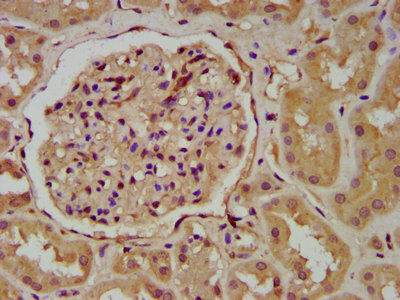Description
| Antibody Name: | WNT9B Antibody (PACO58040) |
| Antibody SKU: | PACO58040 |
| Size: | 50ug |
| Host Species: | Rabbit |
| Tested Applications: | ELISA, IHC |
| Recommended Dilutions: | ELISA:1:2000-1:10000, IHC:1:200-1:500 |
| Species Reactivity: | Human |
| Immunogen: | Recombinant Human Protein Wnt-9b protein (213-324AA) |
| Form: | Liquid |
| Storage Buffer: | Preservative: 0.03% Proclin 300 Constituents: 50% Glycerol, 0.01M PBS, pH 7.4 |
| Purification Method: | >95%, Protein G purified |
| Clonality: | Polyclonal |
| Isotype: | IgG |
| Conjugate: | Non-conjugated |
 | IHC image of PACO58040 diluted at 1:200 and staining in paraffin-embedded human kidney tissue performed on a Leica BondTM system. After dewaxing and hydration, antigen retrieval was mediated by high pressure in a citrate buffer (pH 6.0). Section was blocked with 10% normal goat serum 30min at RT. Then primary antibody (1% BSA) was incubated at 4°C overnight. The primary is detected by a biotinylated secondary antibody and visualized using an HRP conjugated SP system. |
| Background: | Ligand for members of the frizzled family of seven transmembrane receptors. Probable developmental protein. May be a signaling molecule which affects the development of discrete regions of tissues. Is likely to signal over only few cell diameters (By similarity). |
| Synonyms: | Protein Wnt-9b (Protein Wnt-14b) (Protein Wnt-15), WNT9B, WNT14B WNT15 |
| UniProt Protein Function: | WNT9B: Ligand for members of the frizzled family of seven transmembrane receptors. Probable developmental protein. May be a signaling molecule which affects the development of discrete regions of tissues. Is likely to signal over only few cell diameters. Belongs to the Wnt family.Protein type: Secreted, signal peptide; SecretedChromosomal Location of Human Ortholog: 17q21Cellular Component: proteinaceous extracellular matrix; extracellular space; extracellular regionMolecular Function: frizzled bindingBiological Process: positive regulation of catalytic activity; regulation of protein amino acid phosphorylation; response to retinoic acid; cell fate commitment; Wnt receptor signaling pathway; regulation of asymmetric cell division; in utero embryonic development; Wnt receptor signaling pathway, planar cell polarity pathway; multicellular organismal development; embryonic cranial skeleton morphogenesis; palate development; Wnt receptor signaling pathway through beta-catenin; cellular response to starvation; neuron differentiation; cell-cell signaling; ureteric bud branching; male genitalia development; regulation of tube size |
| UniProt Protein Details: | |
| NCBI Summary: | The WNT gene family consists of structurally related genes that encode secreted signaling proteins. These proteins have been implicated in oncogenesis and in several developmental processes, including regulation of cell fate and patterning during embryogenesis. This gene is a member of the WNT gene family. Study of its expression in the teratocarcinoma cell line NT2 suggests that it may be implicated in the early process of neuronal differentiation of NT2 cells induced by retinoic acid. This gene is clustered with WNT3, another family member, in the chromosome 17q21 region. [provided by RefSeq, Jul 2008] |
| UniProt Code: | O14905 |
| NCBI GenInfo Identifier: | 37181546 |
| NCBI Gene ID: | 7484 |
| NCBI Accession: | AAQ88584.1 |
| UniProt Secondary Accession: | O14905,Q6UXT4, Q96Q09 |
| UniProt Related Accession: | O14905 |
| Molecular Weight: | 39,001 Da |
| NCBI Full Name: | WNT9B |
| NCBI Synonym Full Names: | wingless-type MMTV integration site family, member 9B |
| NCBI Official Symbol: | WNT9B |
| NCBI Official Synonym Symbols: | WNT15; WNT14B |
| NCBI Protein Information: | protein Wnt-9b; protein Wnt-14b; wingless-type MMTV integration site family, member 15 |
| UniProt Protein Name: | Protein Wnt-9b |
| UniProt Synonym Protein Names: | Protein Wnt-14b; Protein Wnt-15 |
| Protein Family: | Protein |
| UniProt Gene Name: | WNT9B |
| UniProt Entry Name: | WNT9B_HUMAN |






